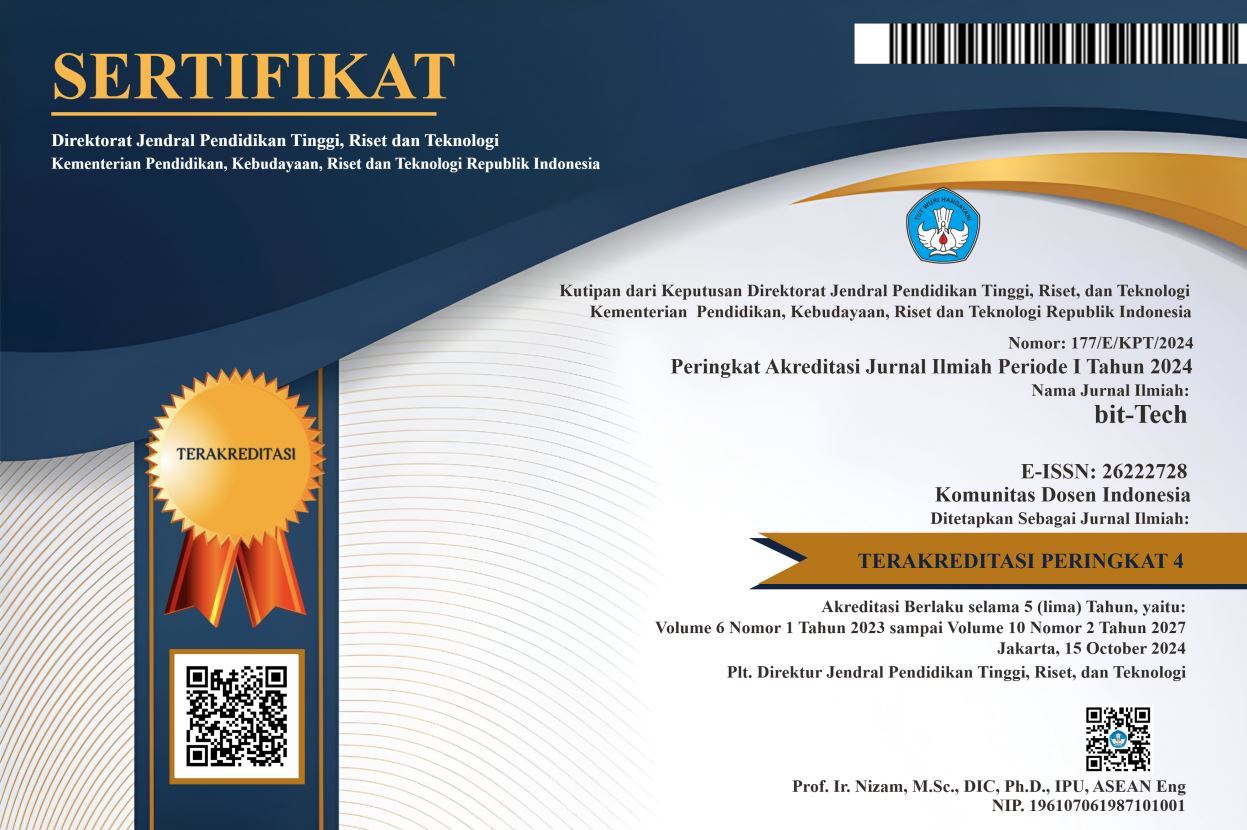Competitive Analysis in Satellite Ground Segment Industry Case Study of PT PC
Keywords:
Business Model Canvas , Case Study, Competitive Analysis, Porter’s Five Forces, Satelite Ground Segment
Abstract
The industry of providing devices and system integrators satellite ground segment is currently starting to erode with more efficient replacement telecommunications technologies such as fiber optic, wireless, and so on. In addition, satellite companies have begun to enter systems integrators business as one stop solution for customers. So, it is necessary for the provider of satellite ground segment devices and systems to re-analyze and to adjust their business strategy, to be more competitive, grow, avoid stagnation and losses. This paper used description methodology with case studies. PT PC in this case study is one of the ground segment satellite devices and system integrator company in Indonesia. This paper analyzes and provides points of advice to be done related to the results of the company's conclusions on situations and conditions using Michael Porter's 5 competitive forces and Business Model Canvas. As a result of the analysis, PT PC should strengthen the company with its uniqueness and upgrade the expertise, get more buyers and suppliers, and do diversification products and services to offset the substitutes. This paper has limitations which could be further interesting topics for the next paper.
Downloads
References
ASSI, Handbook Training. Bandung: The Indonesian Satellite Association, 2021.
Facts and Factors, “Satellite Market Size, Share Global Analysis Report, 2022 – 2028.” Accessed: Apr. 25, 2024. [Online]. Available: https://www.fnfresearch.com/satellite-market
M. E. Porter, Competitive Strategy: Techniques for Analyzing Industries and Competitor. New Introduction. Free Press, 2008.
Rouzni, “55 Perusahaan Pengguna Satelit di Indonesia Terdata .” [Online]. Available: https://inet.detik.com/telecommunication/d-599420/55-perusahaan-pengguna-satelit-di-indonesia-terdata
G. H. Th. Bruijl, “The Relevance of Porter’s Five Forces in Today’s Innovative and Changing Business Environment,” SSRN Electronic Journal, 2018, doi: 10.2139/ssrn.3192207.
L. Kohnová and N. Salajová, “Re-Thinking Industry 4.0 Effect on Competitive Forces: Empirical Study on Innovation,” Sustainability, vol. 15, no. 3, p. 2637, Feb. 2023, doi: 10.3390/su15032637.
H. Hisan, N. A. Badruddin, and K. H. Yusof, “A Review of Malaysia’s Aerospace Manufacturing Post-COVID19 Pandemic Using Michael Porter’s Five Competitive Forces Model,” E3S Web of Conferences, vol. 477, p. 00048, Jan. 2024, doi: 10.1051/e3sconf/202447700048.
R. Wijaya, I. Yusuf, U. Pendidikan Indonesia, and C. Author, “Strategic Analysis Of Tasco Minimart In Tasikmalaya City By Porter Five Forces Analisis Strategi Pada Tasco Minimart Di Kota Tasikmalaya Dengan Porter Five Forces,” 2023. [Online]. Available: http://journal.yrpipku.com/index.php/msej
A. Anggraeni and I. Yulia, “The Digital Marketing Strategy of Batik Sasirangan: An Overview,” in 2022 13th International Conference on E-business, Management and Economics, New York, NY, USA: ACM, Jul. 2022, pp. 64–66. doi: 10.1145/3556089.3556104.
N. Koshkinbayeva, Z. Shagataeva, A. Utepova, K. Taukebayeva, and S. Kurmantayeva, “Exploring pre-service visual art teachers’ competitiveness through porter’s five forces model,” J Educ Elearn Res, vol. 10, no. 3, pp. 389–396, Jun. 2023, doi: 10.20448/jeelr.v10i3.4726.
J. Maartens and D. W. Hutmacher, “Porter’s Five Forces Analysis: Quo Vadis Immunotherapy Industry,” in Novel Innovation Design for the Future of Health, Cham: Springer International Publishing, 2022, pp. 391–408. doi: 10.1007/978-3-031-08191-0_31.
J. Rajasekar and M. Al Raee, “An analysis of the telecommunication industry in the sultanate of oman using michael porter’s competitive strategy model,” Competitiveness Review, vol. 23, no. 3, pp. 234–259, 2013, doi: 10.1108/10595421311319825/FULL/XML.
A. Yameen, “Porter’s Five Forces on Us Telecom Industry.” [Online]. Available: https://www.academia.edu/37058445/Porter_s_Five_Forces_on_Us_Telecom_Industry
A. Osterwalder and Y. Pigneur, Business Model Generation: A Handbook for Visionaries, Game Changers, and Challengers. Wiley, 2010.
S. K. A. Kumar, R. Stewart, D. Crawford, and S. Chaudhari, “Business model for rural connectivity using multi-tenancy 5G network slicing,” in HONET 2020 - IEEE 17th International Conference on Smart Communities: Improving Quality of Life using ICT, IoT and AI, Institute of Electrical and Electronics Engineers Inc., Dec. 2020, pp. 182–188. doi: 10.1109/HONET50430.2020.9322837.
A. Osterwalder, Y. Pigneur, G. Bernarda, and A. Smith, Value Proposition Design. New Jersey: Wiley, 2014.
Strategizer, “The Value Proposition Canvas.” [Online]. Available: https://www.strategyzer.com/library/the-value-proposition-canvas
Sabri M. O., Al-Qawasmi K., Odeh M., and Aydin M.E., “Adoption of Business Model Canvas in Exploring Digital Business Transformation,” Information Sciences Letters, vol. 12, no. 2, pp. 845–854, Feb. 2023, doi: 10.18576/isl/120225.
M. Hamwi, I. Lizarralde, and J. Legardeur, “Demand response business model canvas: A tool for flexibility creation in the electricity markets,” J Clean Prod, vol. 282, p. 124539, Feb. 2021, doi: 10.1016/J.JCLEPRO.2020.124539.
P. D. Rigo, J. C. M. Siluk, D. P. Lacerda, and J. P. Spellmeier, “Competitive business model of photovoltaic solar energy installers in Brazil,” Renew Energy, vol. 181, pp. 39–50, Jan. 2022, doi: 10.1016/J.RENENE.2021.09.031.
G. Cardeal, K. Höse, I. Ribeiro, and U. Götze, “Sustainable Business Models–Canvas for Sustainability, Evaluation Method, and Their Application to Additive Manufacturing in Aircraft Maintenance,” Sustainability 2020, Vol. 12, Page 9130, vol. 12, no. 21, p. 9130, Nov. 2020, doi: 10.3390/SU12219130.
K. Kajtazi, G. Rexhepi, A. Sharif, and I. Ozturk, “Business model innovation and its impact on corporate sustainability,” J Bus Res, vol. 166, p. 114082, Nov. 2023, doi: 10.1016/J.JBUSRES.2023.114082.
S. D. Pratiwi, H. Mulyadi, and H. Hendrayati, “Analysis of business model canvas to increase competitiveness,” Advances in Business, Management and Entrepreneurship, pp. 930–937, Jan. 2020, doi: 10.1201/9780429295348-197.
A. Morrison and R. Chung, “Thuraya Satellite Telecommunications Porter Five (5) Forces Analysis & Solution/ MBA Resources.” [Online]. Available: https://embapro.com/frontpage/porter5forcesanalysis/10901-thuraya-satellite
K. N. P. Wicaksono and C. Apriono, “Literature review: visible light communication system business model scheme for telecommunication business in Indonesia,” MATRIX:Jurnal Manajemen Teknologi dan Informatika, vol. 13, no. 2, pp. 80–93, Jul. 2023, doi: 10.31940/matrix.v13i2.80-93.
Downloads
Published
How to Cite
Issue
Section
License
Copyright (c) 2024 bit-Tech : Binary Digital - Technology

This work is licensed under a Creative Commons Attribution-ShareAlike 4.0 International License.
I hereby assign and transfer to bit-Tech all exclusive copyright ownership rights to the above work. This includes, but is not limited to, the right to publish, republish, downgrade, distribute, transmit, sell, or use the work and other related materials worldwide, in whole, or in part, in all languages, in electronic, printed, or any other form of media, now known or hereafter developed and reserves the right to permit or license a third party to do any of the above. I understand that this exclusive right will belong to bit-Tech from the date the article is accepted for publication. I also understand that bit-Tech, as the copyright owner, has sole authority to license and permit reproduction of the article. I understand that, except for copyright, any other proprietary rights associated with the work (e.g. patents or other rights to any process or procedure) must be retained by the author. In addition, I understand that bit-Tech permits authors to use their papers in any way permitted by the applied Creative Commons license.


 Abstract views: 320
/
Abstract views: 320
/  PDF downloads: 124
PDF downloads: 124











